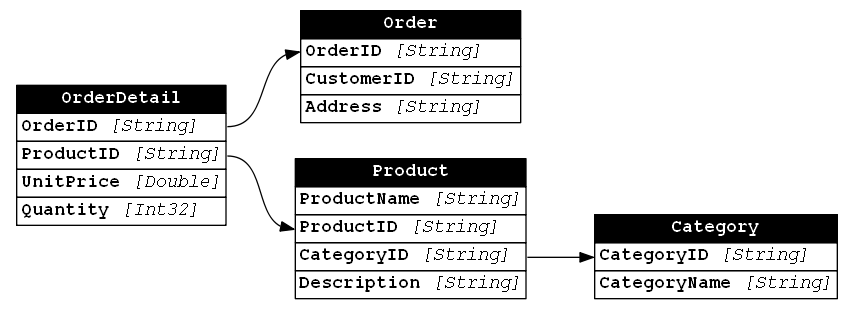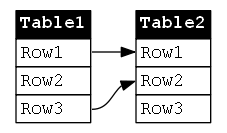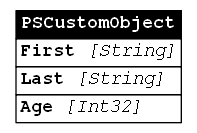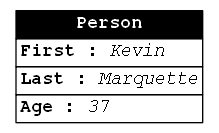I just released another major update to PSGraph. This release includes new keywords and helps unlock more features of Graphviz. These features will make it easier to build entity and data model diagrams.

Index
Release notes
2.1.17 20180217
* add Record command
* add Row command
* add Entity command
* add Show-PSGraph command
* add key name case correction
* throws error when there are Graphviz parse errors
Record
A record is a column of values in a single node.
Graph {
Record -Name Table1 -Rows @(
'Row1'
'Row2'
'Row3'
)
} | Show-PSGraph
This will produce a node that looks like this:

Under the covers, this is a node object. The command takes care of all the attributes and HTML label formating for you. Because this is a Node, you can created edges to it like you would any other node.
Graph {
Record -Name Table1 -Rows @(
'Row1'
'Row2'
'Row3'
)
Node Other
Edge Other -To Table1
}
I offer a lot of flexible ways to work with the Record command. Here is the minimal DSL style syntax:
Graph {
Record Table1 @(
'Row1'
'Row2'
'Row3'
)
}
Just knowing that the 2nd default parameter is an array opens up many options.
$list = @(
'Row1'
'Row2'
'Row3'
)
Record Table1 $list
$list | Record -Name Table2
-ScriptBlock
Having an array for the second parameter of a PowerShell DSL is not that common. So I also added support for using a scriptblock. It works the same as the array in many cases.
Graph {
Record Table1 {
'Row1'
'Row2'
'Row3'
}
}
We will make better use of that scriptblock when I introduce the Row command.
Row
The Row command is used with the Record to make a much richer object.
Graph {
Record Table1 {
Row 'Row1'
Row 'Row2'
Row 'Row3'
}
}
If you take a close look at the Row command, it has 3 parameters.
Row -Label 'MY row' -Name 'Port1' -EncodeHTML
The -Label is the text that you see in the record. The -Lable is the default parameter when no parameter is specified. The label supports simple HTML.
Row 'My Row' -Name 'Port1'
Row -Label 'First: <B>Kevin</B>'
Because the label is rendered as HTML, I added -EncodeHTML for when you data includes characters like <>& that can mess with the HTML syntax.
Row -Label 'Mom & Dad' -EncodeHTML
-Name
You can name a row like you name a node. By giving a row a name, we can target it with an edge.
Graph {
Record Table1 {
Row 'Row1' -Name Row1
Row 'Row2' -Name Row2
Row 'Row3' -Name Row3
}
Record Table2 {
Row 'Row1' -Name Row1
Row 'Row2' -Name Row2
Row 'Row3' -Name Row3
}
Edge Table1:Row1 -to Table2:Row1
Edge Table1:Row3 -to Table2:Row2
} | Show-PSGraph

If the label is a simple word with no spaces or symbols, the row will use that as the default row name. If you start injecting custom HTML into your row, then there will not be a default row name.
The Graphviz documentation refers to those row names as ports on the node.
Entity
The Entity command takes an object and maps it into a Record. This turned out to be a common pattern in how I was trying to use the Record.
$object = [PSCustomObject]@{
First = 'Kevin'
Last = 'Marquette'
Age = 37
}
Graph {
Entity $object
} | Show-PSGraph

I provide 3 different views of the object with the -Show parameter. Here are the possible options.
Name- Property nameTypeName- Name and value typeValue- Name and value
Here is the same object showing the values.
Graph {
Entity $object -Name 'Person' -Show Value
} | Show-PSGraph

The entity will automatically name each row with the property name. This will allow you to draw edges directly to them. I have a more complex example at the end of this article that shows this in action.
-Name
If you have a small collection of objects that you want to place on a graph, make sure you give each one a custom name.
$servers = Import-CSV .\myservers.csv
Graph {
$servers | ForEach-Object {
Entity $PSItem -Name $PSItem.ComputerName
}
}
-Property
The -Property parameter allows for easy filtering of the properties that you want to display.
Entity $Server -Property ComputerName, CPU, Memory, IP, Location
Show-PSGraph
The Export-PSGraph command has a parameter called -ShowGraph that will show the graph after generating it. This release added Show-PSGraph that does the same thing with one command.
Graph {
Node test
} | Show-PSGraph
Pulling it together
I opened the article with a table diagram showing the Entity command in action. I create 4 hahstables that represent database tables. I provide sample data so the types can be auto-discovered. I add all 4 of them to the graph as an Entity with a -Name. Then I create edges between the properties that would be the primary and foreign key relationships.
$product = [ordered]@{
ProductName = 'Sandbox'
ProductID = 'P4576'
CategoryID = 'C728'
Description = 'Tractor tire with sand'
}
$Category = [ordered]@{
CategoryID = 'C728'
CategoryName = 'Backyard'
}
$OrderDetail = [ordered]@{
OrderID = 'O3294'
ProductID = 'P4576'
UnitPrice = 280.00
Quantity = 1
}
$Order = [ordered]@{
OrderID = 'O3294'
CustomerID = 'C1034'
Address = '123 Street, Irvine CA'
}
Graph @{rankdir='LR'} {
Entity $Product -Name Product
Entity $Category -Name Category
Entity $OrderDetail -Name OrderDetail
Entity $Order -Name Order
Edge Product:CategoryID -to Category:CategoryID
Edge OrderDetail:OrderID -to Order:OrderID
Edge OrderDetail:ProductID -to Product:ProductID
} | Show-PSGraph

Here is that same diagram with -Show Value specified for each Entity:

I pulled that data model from Scott Guthrie’s LINQ to SQL (Part 2 - Defining our Data Model Classes) article because it was such a great sample model.
Closing remarks
For people coming from Graphviz, the Record is not a true record object as defined by the DOT language specification. I am using the HTML markup options to create this node. The base commands will continue to align closely with the Graphviz DOT language. As I add new commands, they will start to abstract away the underlying complexity.
I don’t offer a lot of customization on these new objects yet. The look and style is a little rigid for now. I have not decided on the best way to expose and implement the styling options yet.
I have already found the use of Record to be useful in my graphs. I should have added it a long time ago. If you find any bugs or unexpected behavior, feel free to open an issue on the GitHub project page.
The 2.1.17 release is already live on the PSGallery.
Find-Module PSGraph | Install-Module